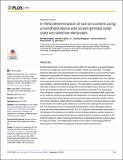In-field determination of soil ion content using a handheld device and screen-printed solid-state ion-selective electrodes
Author(s)
Rosenberg, Ron; Bono Jr, Michael S; Braganza, Soumya; Vaishnav, Chintan H.; Karnik, Rohit; Hart, Anastasios John; ... Show more Show less
Downloadjournal.pone.0203862.pdf (16.67Mb)
PUBLISHER_CC
Publisher with Creative Commons License
Creative Commons Attribution
Terms of use
Metadata
Show full item recordAbstract
Small-holding farmers in the developing world suffer from sub-optimal crop yields because they lack a soil diagnostic system that is affordable, usable, and actionable. This paper details the fabrication and characterization of an integrated point-of-use soil-testing system, comprised of disposable ion-selective electrode strips and a handheld electrochemical reader. Together, the strips and reader transduce soil ion concentrations into to an alphanumeric output that can be communicated via text message to a central service provider offering immediate, customized fertilizer advisory. The solid-state ion-selective electrode (SSISE) strips employ a two-electrode design with screen-printable carbon nanotube ink serving as the electrical contacts for the working and reference electrodes. The working electrode comprises a plasticizer-free butyl acrylate ion-selective membrane (ISM), doped with an ion-selective ionophore and lipophilic salt. Meanwhile, the reference electrode includes a screen-printed silver-silver chloride ink and a polyvinyl-butyral membrane, which is doped with sodium chloride for stable reference potentials. As a proof of concept, potassium-selective electrodes are studied, given potassium's essential role in plant growth and reproduction. The ISE-based system is reproducibly manufactured to yield a Nernstian response with a sub-micromolar detection limit (pK+ of 5.18 ± 0.08) and near-Nernstian sensitivity (61 mV/decade) in the presence of a 0.02 M strontium chloride extraction solution. Analysis of soil samples using the printed electrodes and reader yielded a correlation coefficient of R2 = 0.89 with respect to values measured via inductively coupled plasma atomic emission spectroscopy (ICP-AES). The reliable performance of this system is encouraging toward its deployment for soil nutrient management in resource-limited environments.
Date issued
2018-09Department
Massachusetts Institute of Technology. Computer Science and Artificial Intelligence Laboratory; Massachusetts Institute of Technology. Department of Materials Science and Engineering; Massachusetts Institute of Technology. Department of Mechanical Engineering; Massachusetts Institute of Technology. Department of Political Science; Massachusetts Institute of Technology. Institute for Data, Systems, and Society; Sloan School of ManagementJournal
PLOS ONE
Publisher
Public Library of Science
Citation
Rosenberg, Ron, Michael S. Bono, Soumya Braganza, Chintan Vaishnav, Rohit Karnik, and A. John Hart. “In-Field Determination of Soil Ion Content Using a Handheld Device and Screen-Printed Solid-State Ion-Selective Electrodes.” Edited by Virgilio Mattoli. PLOS ONE 13, no. 9 (September 25, 2018): e0203862.
Version: Final published version
ISSN
1932-6203